
| What is Flavor and Fortune? |
| How do I subscribe? |
| How do I get past issues? |
| How do I advertise? |
| How do I contact the editor? |
Read 13146269 times
Connect me to:
| Home |
| Articles |
| Book reviews |
| Letters to the Editor |
| Newmans News and Notes |
| Recipes |
| Restaurant reviews |
| Article Index (all years, slow) |
| List of Article Years |
| Article Index (2026) |
| Article Index (last 2 years) |
| Things others say |
| Related Links |
| Log In... |
| Authors |
| Categories & Topics |
Chinese Pumpkin
| by Jacqueline M. Newman |
Vegetables and Vegetarian Foods
Spring Volume: 2008 Issue: 15(1) page(s): 12, 24, and 25
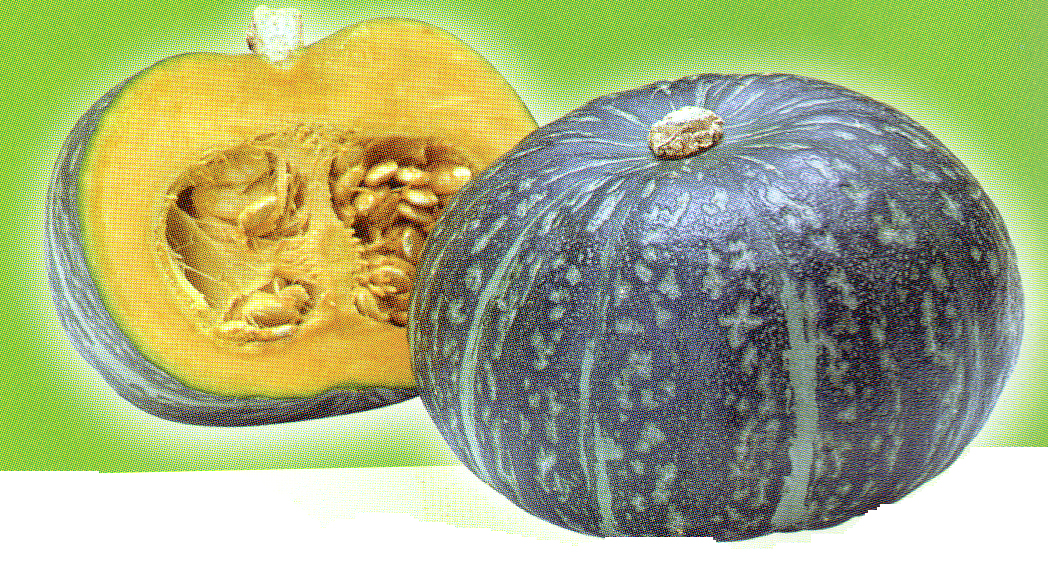
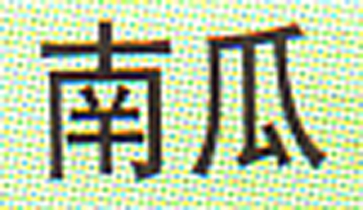 Used as a vegetable, but technically it is not one, this fruit growing on a vine. It is a member of the Cucurbitaceae family. Some call it a squash, others more correctly know it is a pumpkin. No matter its name, it is not a true vegetable. This one we call a Chinese pumpkin, and it is botanically known as Cucurbita moschata. Chinese call all pumpkins, nan gua, though specifically and correctly, they refer to this one as 'round box' or he gua. Some call it fan gua or 'foreign melons' while others say it is 'food melon.'
Used as a vegetable, but technically it is not one, this fruit growing on a vine. It is a member of the Cucurbitaceae family. Some call it a squash, others more correctly know it is a pumpkin. No matter its name, it is not a true vegetable. This one we call a Chinese pumpkin, and it is botanically known as Cucurbita moschata. Chinese call all pumpkins, nan gua, though specifically and correctly, they refer to this one as 'round box' or he gua. Some call it fan gua or 'foreign melons' while others say it is 'food melon.'
Never mind, just know its stem and top are flattened, the pumpkin itself ball-shape, covered with very short stiff hairs that most people do not even realize they are there. Depending upon the variety, sometimes the season, even where it grows, the leaves on this pumpkin's vine can be circular, egg-shaped, five-cornered, or with shallow splits along its edges. Nomenclature and other confusions aside, this pumpkin is, as the picture shows, green on the outside. orange within; the outside has grooves and a somewhat concave top and bottom.
Why is it foreign? Because it was introduced into China some time before or in the very early part of the Ming Dynasty about 1368 CE when this dynasty began, and then it was new and notable. So popular was it right from the start, that the Imperial family used it as an offering, particularly during the Fifth Moon month. At home, when used as such, they set it before the spirit tablets for their forebears. At temples they used it along with gourds, wild lettuce, eggplant, haw apples, peaches and plums, grains of wheat and barley, noodles made with wheat, and pullets and shad.
When tracing origins of a food, not everyone agrees. Some say the pumpkin's Chinese arrival was in the twelfth century. Others tell it was already popular a few hundred years before that, as it was elsewhere in the world. Seeds of nan gua and he gua found in Mexico were radio-carbon dated circa 3400 BCE; no Chinese early ones have been. Though, another Cucurbita, namely the Cucurbita maxima, was used in many parts of Asia before the Chinese pumpkin got there. The Japanese call it kabocha. With many different names, dates of origin, and places found in Asian countries, there is considerable confusion.
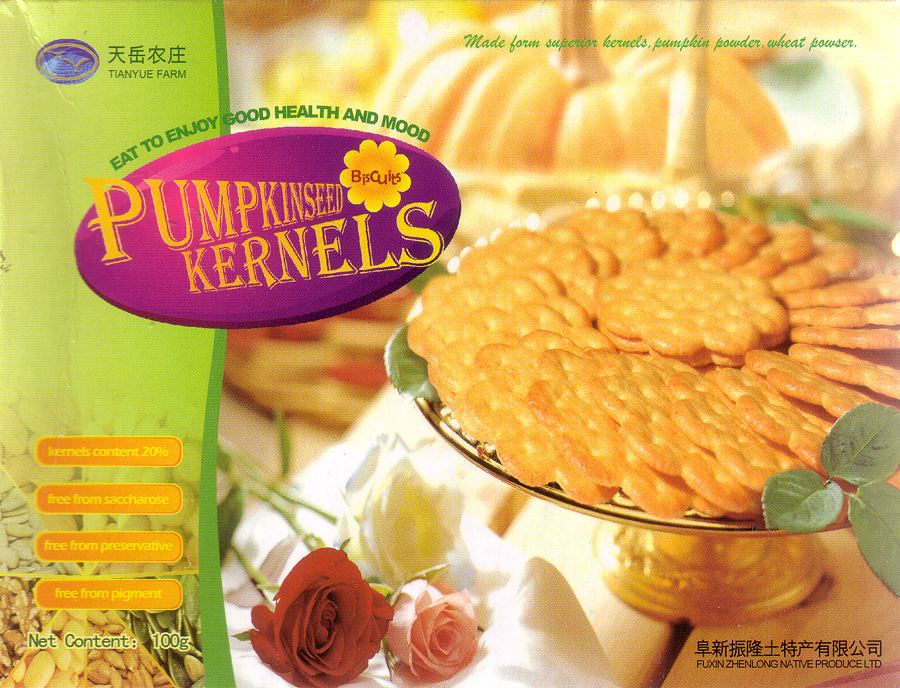 What is not confusing is how the Chinese consume and like it and how they prepare it. They prefer theirs mature and dark green, and they recognize it by the small bumps on its exterior skin; technically, called warts. When this pumpkin reaches maturity, it is deep orange within, before that it is greenish-yellowish-orange. The Chinese like to pick it when it is about eight inches in diameter, and between two and five pounds in weight. And, they use it as Americans use winter squash.
What is not confusing is how the Chinese consume and like it and how they prepare it. They prefer theirs mature and dark green, and they recognize it by the small bumps on its exterior skin; technically, called warts. When this pumpkin reaches maturity, it is deep orange within, before that it is greenish-yellowish-orange. The Chinese like to pick it when it is about eight inches in diameter, and between two and five pounds in weight. And, they use it as Americans use winter squash.
This variety, whose general name translates to 'southern gourd' keeps well at cool to room temperatures. They like the fact that it can be kept up to six months when kept cool, but not cold. When immature, they like it stir-fried with mustard greens or others leafy vegetables. This pumpkin is used in both sweet and savory dishes, and it can be used fresh, dried, or frozen, and raw or cooked. Nan gua and he gua are loved in soups, when stir-fried, and when salted or preserved in sugar.
Drying a Chinese pumpkin, peel it first, then remove its seeds. Do not discard them, simply remove all stringy pumpkin material, rinse and drain, then set aside for another use. Next, slice the flesh into one-eighth to one-quarter inch pieces, and then cut crosswise into thin strips. Boil a large pot of water, drop them in for one or two minutes, drain, and dry the slices in a very low oven or an electric fruit/vegetable dryer. Chinese children like to carry this dried food to school; and they and adults eat them as snacks.
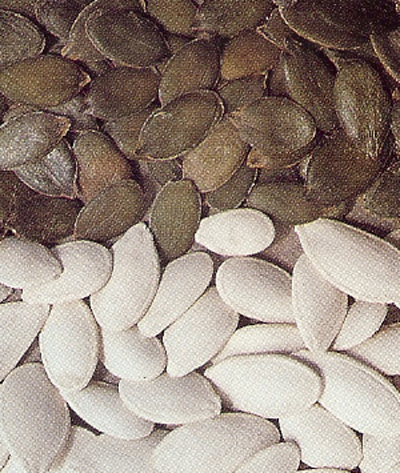 Pumpkin seeds, to be edible, need to be sun- or oven-dried, pan-fried, or dry-roasted. They can also be candied by cooking them in sugar with or without soy sauce, then drying them. Some seeds are coated with lots of salt, like the white ones in the picture with this article. In markets, they are sold plain or that way in their shells or with shells removed. When shelled, aside from snack food, they are used in bakery products such as crackers, as toppings, in or on some dishes, and used as are any other kind of nuts.
Pumpkin seeds, to be edible, need to be sun- or oven-dried, pan-fried, or dry-roasted. They can also be candied by cooking them in sugar with or without soy sauce, then drying them. Some seeds are coated with lots of salt, like the white ones in the picture with this article. In markets, they are sold plain or that way in their shells or with shells removed. When shelled, aside from snack food, they are used in bakery products such as crackers, as toppings, in or on some dishes, and used as are any other kind of nuts.
Stuffing a pumpkin, cut a two- or three-inch circle in the top and remove this part but do not discard it. Then cut half the orange inside part off this cover and reserve it to close the pumpkin after stuffing and before steaming. Next, remove the seeds, and wash them, and set them aside for another use. Fill the inside cavity of the pumpkin with meat, fish, or vegetables, or any combination thereof, put the cover on, and steam the pumpkin for between sixty to eighty minutes, or until the flesh feels soft. A pumpkin can also be filled with soup in its cavity, however, then only cook it for about forty minutes until the flesh feels soft.
Pumpkins can be mealy when ripe and undercooked. When cooked properly, they have a fine texture and a sweet taste. Some friends told us that when they were young, their mothers filled one with rice or millet or both, and steamed it serving it as their only dinner dish. Others spoke of eating a related variety that looked more like a tear drop; that one was C. maxima. Either variety when picked before it matures, is best cubed and stir-fried with mustard or other greens. Pumpkin is considered warm in nature, and a food that affects spleen and stomach. The seeds are neither warm nor cool, though some traditional medical doctors (TCM) say they are slightly warm. The seeds, TCM practitioners say, can expel internal parasites, pumpkin flesh can not. The seeds are egg-shaped and thin, with either cream-colored or white shells and white or green interiors. These TCM medical folk tell us they benefit the intestines.
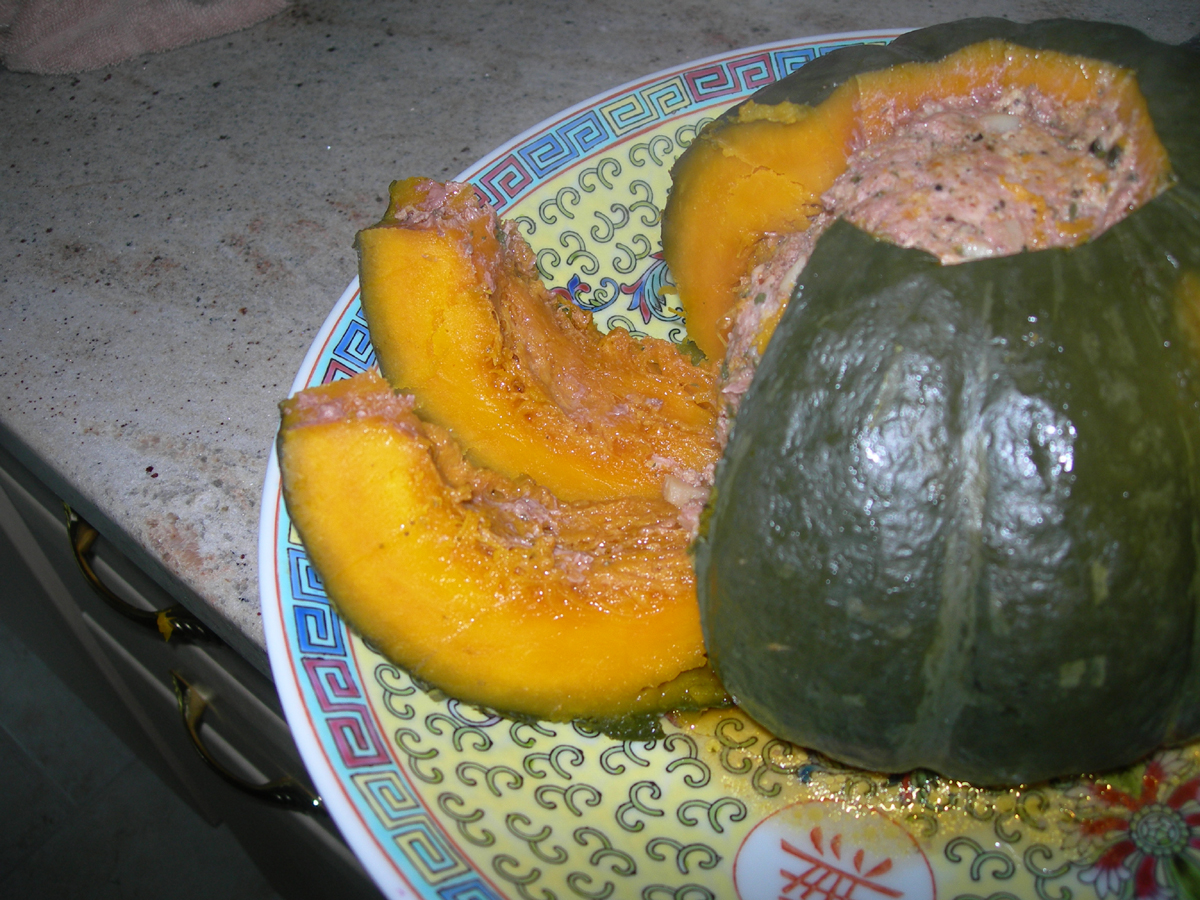 Serving stuffed pumpkin is quite popular. The first time we had one made that way was in a restaurant on Bayard Street in New York City’s Chinatown. That eatery, called Danny Ng is no longer there, but they used the flat-topped variety. While this stuffed dish can be made from any number of foods in the squash/pumpkin family, it is the most popular in the one shown with this article. The restaurant stuffed theirs with minced beef and water chestnuts.
Serving stuffed pumpkin is quite popular. The first time we had one made that way was in a restaurant on Bayard Street in New York City’s Chinatown. That eatery, called Danny Ng is no longer there, but they used the flat-topped variety. While this stuffed dish can be made from any number of foods in the squash/pumpkin family, it is the most popular in the one shown with this article. The restaurant stuffed theirs with minced beef and water chestnuts. 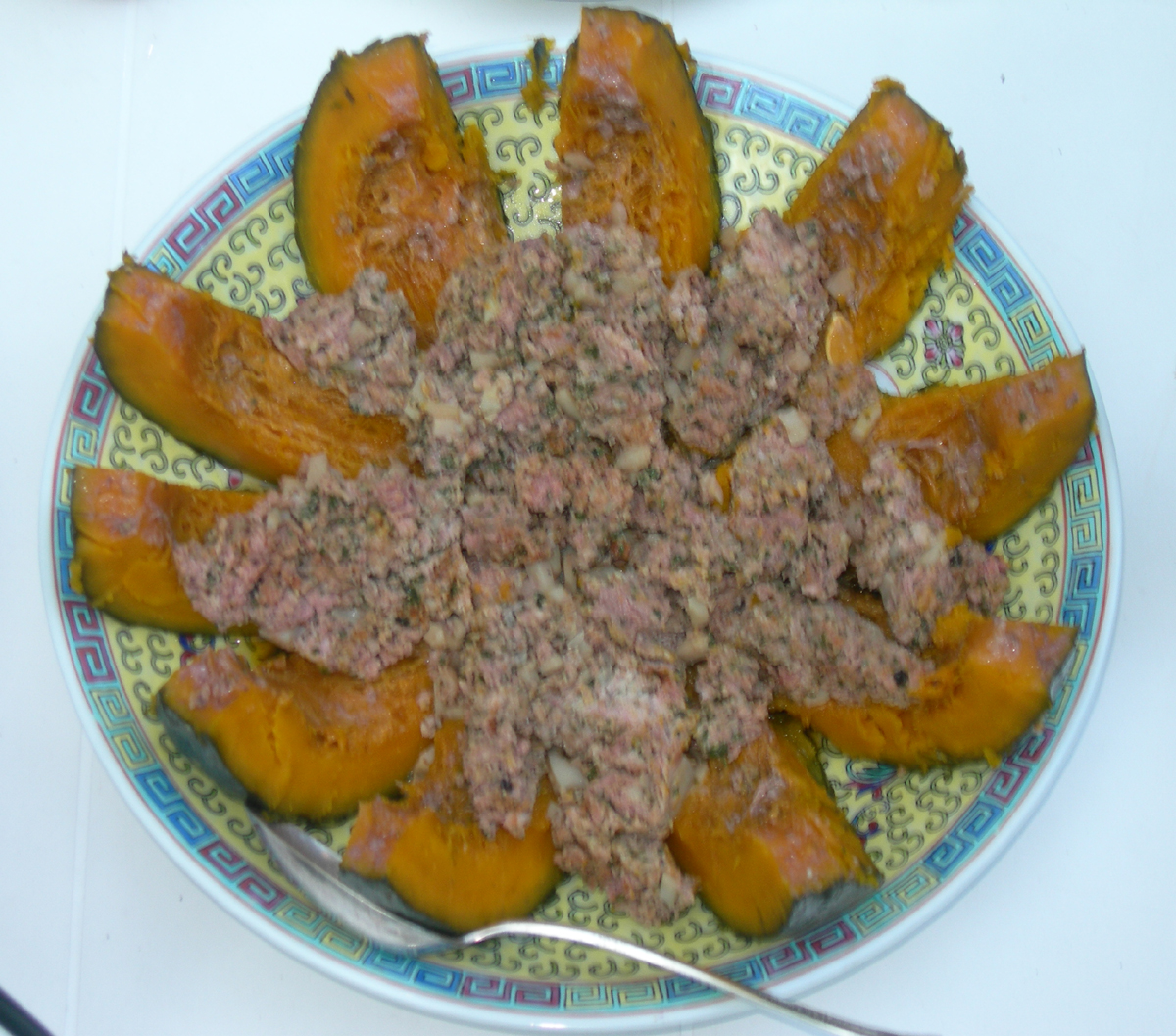 What was most impressive was it arrived sitting on a large platter and looking lonesome. After they removed the small cover, they cut it top to almost the bottom every inch or so all around it and when they did that last cut, it fell open like a flower. What a beautiful presentation theirs, and the one we made to demonstrate what it looks like starting to cut it and when done and it falls out like a flower.
What was most impressive was it arrived sitting on a large platter and looking lonesome. After they removed the small cover, they cut it top to almost the bottom every inch or so all around it and when they did that last cut, it fell open like a flower. What a beautiful presentation theirs, and the one we made to demonstrate what it looks like starting to cut it and when done and it falls out like a flower.
Making one that way is often on our company dinner table. We fill ours in different ways; and it does garner compliments. Try it and yours will be appreciated, as well.
| Stuffed Chinese Pumpkin |
|---|
1/2 half pound finely minced beef 1/4 pound coarsely hand-chopped pork 1/4 pound shrimp, shell and veins removed, then coarsely chopped 1/4 cup canned water chestnuts, drained and coarsely chopped 1 Tablespoon dark soy sauce 2 teaspoons sesame oil 1/4 teaspoon coarse salt 1/2 teaspoon ground white pepper 2 Tablespoons coarsely chopped scallion, green tops only 2 Tablespoons fresh coriander, coarsely chopped 1 teaspoon cumin seeds 1 Chinese pumpkin (about a pound), center part of top cut out and reserved, seeds removed 1 piece fresh coriander or a few cumin seeds, for garnish Preparation: 1. Gently mix pork, beef, and shrimp. 2. Stir together water chestnuts, soy sauce, sesame oil, salt, pepper, scallion greens, coriander, and cumin seeds. Then stir this into the meat mixture. 3. Stuff into the pumpkin, and set its cover on it. Put this into a bowl and then into a steamer over rapidly boiling water. Steam it for seventy-five minutes. 4. Carefully remove from the steamer and slide pumpkin onto a large flat serving plate, discarding any liquid in the bowl. Discard the pumpkin cover, as well. 5. Cut down every inch or inch and a quarter from top to one inch from the bottom Do not cut though bottom part of the pumpkin. When you do the last cut, the pumpkin will fall out like a flower. Put garnish on top, and serve. |
| Pumpkin Soup |
|---|
1/4 cup dry shrimp, soaked for twenty minutes in warm water, then drained 6 shallots, minced 2 red chilies, seeds and veins removed, then minced 1/2 teaspoon shrimp paste 1 pound Chinese pumpkin, peeled and cubed 1 Tablespoon Chinese rice vinegar 1 teaspoon sacha sauce 8 ounces chicken stock 24 Thai basil leaves, coarsely chopped Preparation: 1. Using a blender or a mortar and pestle, blend dry shrimp, shallots, chili peppers, and shrimp paste with three tablespoons cool water. Put into a large pot and mix well. 2. Add pumpkin, rice vinegar, sacha sauce, chicken stock, and two quarts of water. Bring almost to the boil, reduce heat, and simmer for fifteen minutes. Transfer to a pre-heated soup tureen. 3. Sprinkle basil leaves on top, and serve. |
| Pumpkin, Bitter Melon, and Small Dried Fish |
|---|
1 bitter melon, cut in half, seeds and pith removed, then cut into two-inch by half-inch strips 1 teaspoon coarse salt 1 pound Chinese pumpkin, peeled and cut into two-inch by half-inch strips 1 hundred year preserved duck egg, diced 1 cup vegetable oil 1 cup small dried fish 1 teaspoon broad bean paste 1/2 teaspoon sugar 1 teaspoon thin soy sauce 1 teaspoon sesame oil 1 teaspoon sesame seeds Preparation: 1. Soak bitter melon pieces in two cups of water and coarse salt for half an hour. Drain, rinse, and drain again. 2. Put bitter melon into boiling water for three minutes, drain and put into a serving bowl. 3, Put pumpkin into boiling water and simmer for fifteen minutes, drain, and put into same bowl with the bitter melon. 4 . Heat wok, add oil, and deep fry the small fish until crispy. Drain on paper towels, and add to the items in the bowl. 5. Mix broad bean paste, sugar, soy sauce, and sesame oil and pour over ingredients in the bowl. Toss them, sprinkle with sesame seeds and serve. |

Copyright © 1994-2026 by ISACC, all rights reserved
Address
3 Jefferson Ferry Drive
S. Setauket NY 11720